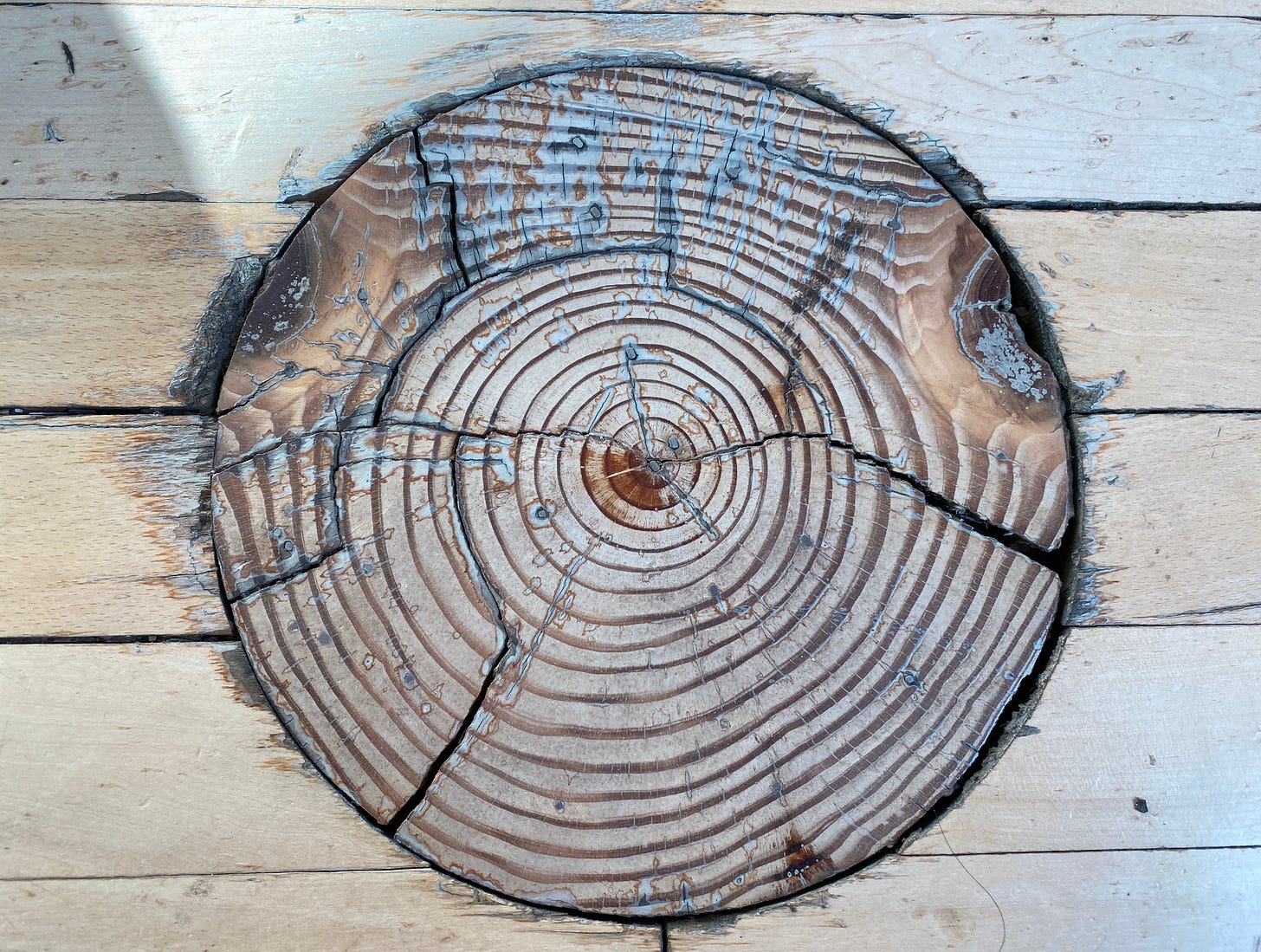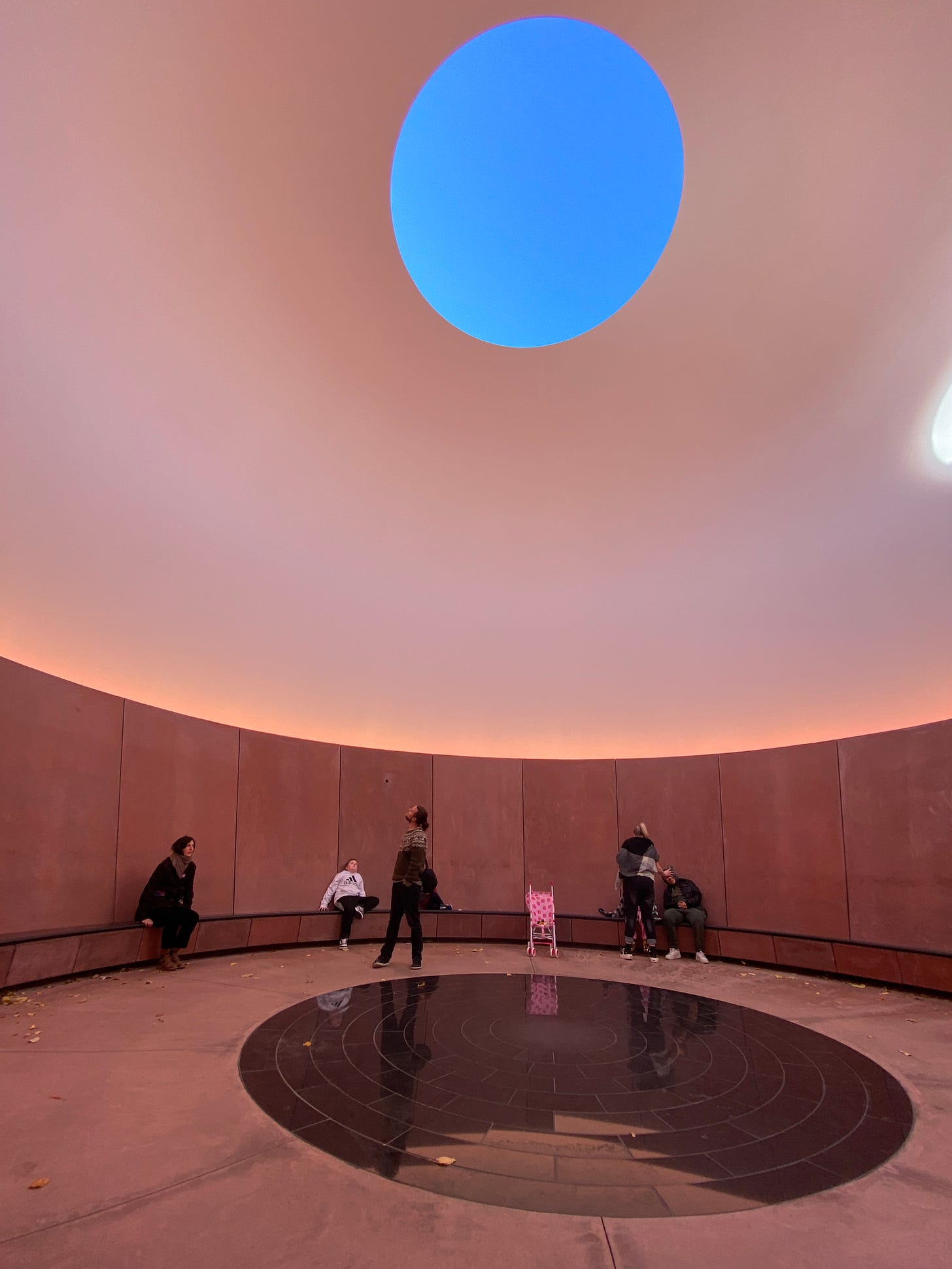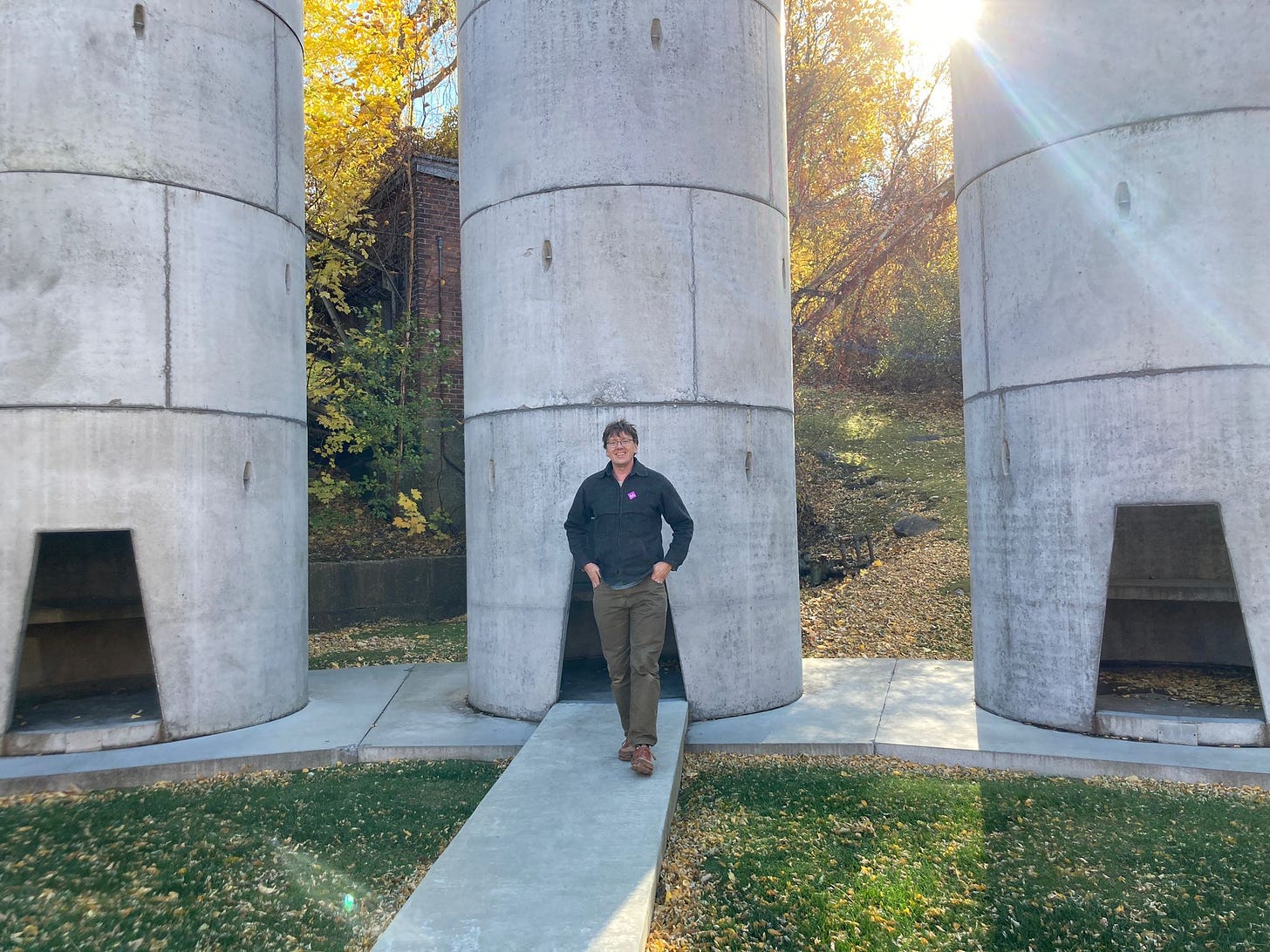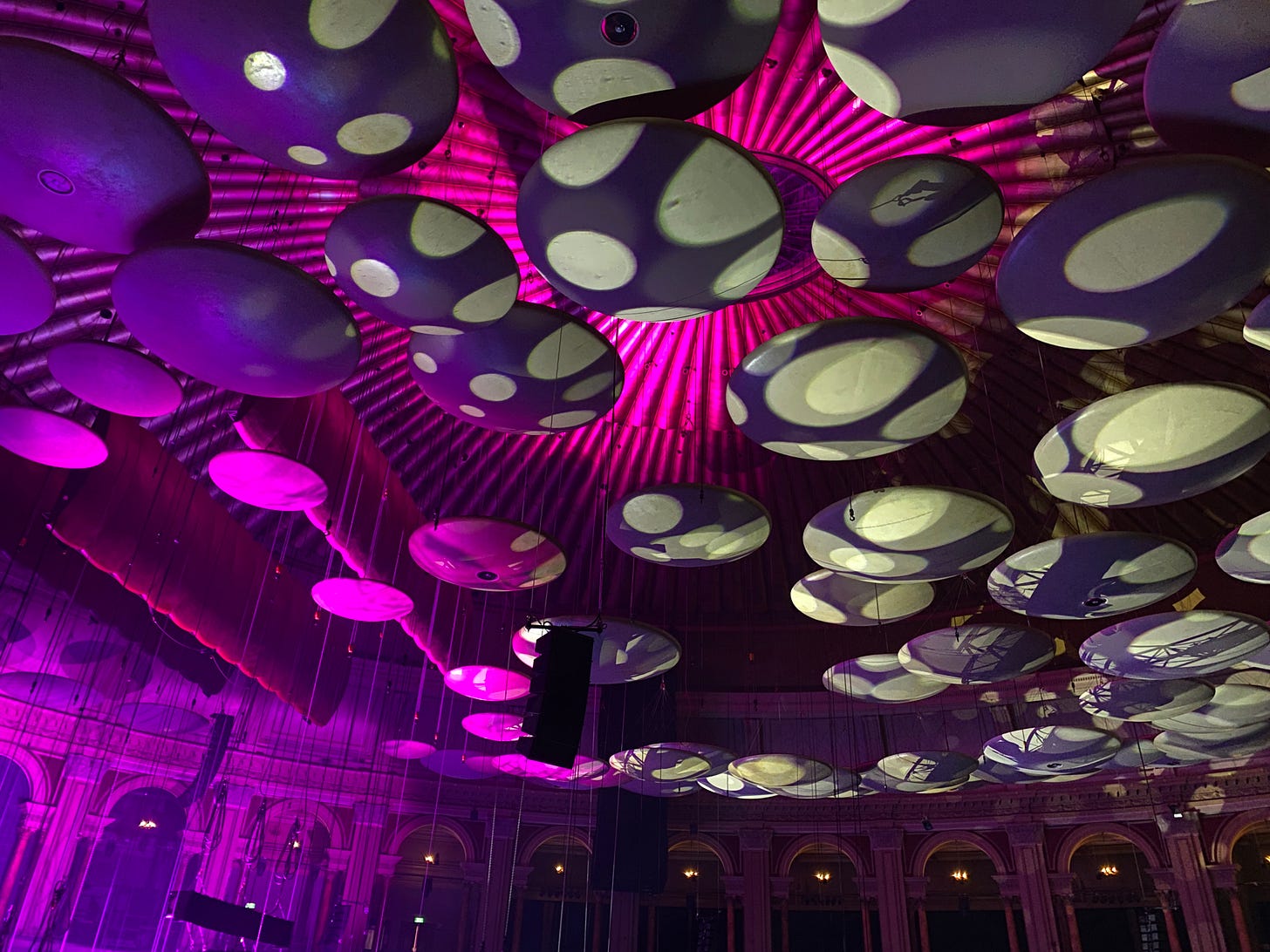
Greetings from my writing desk, 3780 miles from where today’s cover photo was taken, last week. I am starting to feel like all of me is back in one place and at this precise moment coffee is helping with that impression, as well as the sight of lime (linden, basswood) leaves falling from the pollarded street trees in front of me. Behind them, chestnut trees in varying states of autumnal deshabille are shimmering in the breeze, reminding me that I completely missed the chestnut foraging season this year. Grey squirrels taunt me fatly from the branches high above their stashes. Am I bovvered? Yes, somewhat, but being away from gathering that particular ancestral sustenance was worth it on account of the heart-filling time that took its place half a world away.
This week, growth, orientation, harmony, improvisation: all the good things.
Next week, a new way of looking at AI.
Warm wishes to you from not-quite-yet lunchtime in England.
Where the Light Falls
Look again at the growth rings in the photo above. Notice how slender and crowded they are in the top of the circle compared to the area on the lower-left. This tree was likely felled near where it was used, near North Adams, Massachusetts, sometime in the late nineteenth century. In heavily forested areas like the hills and valleys around the Hoosic river, conifers such as pine and spruce grew tall and were used in buildings as pillars, structural timbers and flooring. At Mass MOCA I could have filled my camera reel with pleasingly crunchy textures from almost every post-industrial wall, flaky painted pillar or unevenly glazed old bricks, but this tiny section of floor stole the show, despite the array of art visible in every direction.
Here in the northern hemisphere, unless shaded by landforms, trees receive the strongest light from the south. They reach in this direction, with branches, leaves or needles. In the cross section above you can see, even in death, what orientation the tree had had in life. That lower widely spaced growth ring section almost certainly faced south and was created due to the increased chemical and biological action which heat from the sun’s rays allowed. The cells in there reproduced more, and for a little longer in the day and the year, than their trunk-mates on the north side.
Since learning this simple correlation, almost every piece of unpainted wood I come across in daily life feels somehow alive again to me. My body recognises as kin something that, too, has stood breathing in the darkness and the light and known warmth and cold. Another being who has reached towards the possibility of growth but had periods where it slowed to a glacial pace. I run my hands over the grain in a block of centuries-old pine, being used as a side table in the gallery, and say, ‘Ah, you were this way round in life, and today you are half a turn widdershins.’

In a room, I always attempt to gauge from which direction most light is entering. It’s not always possible in cloudy old Britain, so you sometimes have to sniff out the source of the lumens by squinting, like a Victorian portraitist, quickly capturing a likeness in pastels. Aspect, the estate agents1 call it; knowing where the light is coming from and how to build in relation to it. Clearly, the builders of this huge factory with its giant floor to ceiling windows, had aspect in mind and increased manufacturing hours as the goal. Aspect was always part of making a home; from castle to yurt, right relation to the cardinal directions was a matter of deep import. Ubiquitous electric light has scoured the modern mind of thoughts of aspect, just as it cauterises the scabs left by the shrinking of our vestigial animal sense of when to work and when to rest, the diurnal rhythm.
Exhausted, bewildered creatures, we stumble from one ill-built, shriek-lit, damp rental pod to another, wondering why we are always fatigued. Herded by landlords and confused by the constant hum of devices, rest seems unlikely, even in these places blessedly still free of dropping bombs.
A regenerative practice: recognise which way you are facing, learn where the light is coming from and how you are oriented in relation to it. Not for monetary gain, not as a game, but as an act of planetary alignment. Solidarity with the cosmos, if you like. Which way are you facing now? At the shop checkout later, where is north? Don’t check a device. Search out the sun at noon, or Ursa Major, or the Southern Cross, at night. Your two favourite places to sit and read, do they have aspect in common? Are you a secret west-facer, when 200 pages deep into a new romantasy? Which way do you face when you pray?
All week since meeting this old ‘dead’ tree, it has been with me, orienting me, making me think about which way I have been growing and towards what I have been reaching, for years. It’s made me wonder how that shows up, how it’s visible. People, like trees, don’t just go straight up, (unless forced to by unnaturally close monocultural conditions…)
If after my death, my life were laid out plainly, like this tree has been, and you could see the side where warmth and light had hit me, could observe the thinner lines of the parts of my life that had remained in the shade, what would an interested onlooker make of it? Would they say, ‘Ah, I see you were turned towards the sun but got overshadowed by a faster-growing tree for a while.’
And what is the sun? Friendship? Love? The Great Mystery?
It’s another way to think of the heart-mind which gives a little more spaciousness, admits the influences of conditions and environment, and doesn’t cling to the popular though ridiculous idea of being self-made. I’m not implying some mystical goal, a psyche formed like perfectly even rings of a tree that receives sun all day as it stands majestically alone in a sunlit field.
I remember the Great Storm of 1987, a rare hurricane which tore across the British Isles. Almost all such lone grand trees were lost in my region. Admired for their huge crown circumferences, when full of leaves, like giant sails, as though a fleet of elite yachts caught in a squall heading towards Cowes Week from Chichester harbour, they each caught the wind, blew over and were wrecked.

All Day Singing and Dinner in the Air
2 Two weeks earlier, driving through leaf fall painted in the rosy shades of Rosetti’s Venus Verticordia,3
taught us Hal An Tow, Shenandoh and a grace fit to frame any meal from a sandwich to a banquet. The fragment of which, ‘Blessings on the meal!’ resounded at every table where we gathered as we headed south then east with other friends. Jonny and I broke into unison or harmony when the mood took us, which was often, and the desire for more group singing in us both just kept building. Inside Oculus, one of James Turrell’s wonderful sky-spaces, our friend Catherine, (below on the left) began to hum beautiful long notes to test the resonance of the space. Soon Jonny and I joined in, then Candace and Owen walked back inside to add their voices. We huddled near the entrance, close enough to hear each other clearly so as to stagger our breaths. For two minutes, we all chimed in, filling the air with improvised chords and the occasional stifled giggle.The utter feral joy of filling such a designed space with such unpremeditated sound. And how well they went together, as though one invited the other.
A little boy of three or four beside me had watched the whole time, open mouthed. I was thinking ‘hurray’, not just for him, but for the easily embarrassed little girl in me who would never have dared to let a sound out just for the joy of it. As we fell silent, the other visitors applauded, and we walked outside laughing.
Around the next corner stood The Pipes by Taryn Simon, silos made into spaces in which five of us could stand together. As soon as we ducked our heads to go in, Catherine started humming and we joined her again. The space was not as sumptuously resonant, as can be imagined from comparing the photographs, but still, we took the opportunity to harmonise inexpertly together, without the need for words or plans. I used my phone voice notes function to record this excerpt.
The rest of our visit was transformed. Structures were echo-explored with mouth clicks and bright plosive ‘pah!’. Huge old metal machinery was serenaded. Deep stairwells were sounded. I have never explored the vestiges of industrial spaces, nor exhibits of contemporary art, with such interest and excitement. I joked, ‘I should apply for funding to get us a rental van so we can tour the fallen down factories and giant artworks of America. We can improvise music for and in them!’ I was joking for about 10 seconds. Then I realised it was something we all wanted to do, making art in the ruins, singing life into them. Perhaps something will come of this.
All week concrete and iron, wood and bronze, asphalt and rubber have felt and sounded different to me. Facts about embodied carbon, production chains, or acoustic qualities of the ordinary world are no longer mundane. The famous ceiling ‘mushrooms’ of the Royal Albert Hall this week, for the poignant last concert by Clannad4, and the glorious sounds they enabled, now sit alongside the memories of my body vibrating beside my friends, breathing in turns, sounding out space. Hearing each other and thereby knowing where to place our own next note. A process of reciprocal becoming.
That was all most certainly ‘this week’s good thing’.
It was hard to board the night plane home: no sleep, no singing, no cornbread, no friends’ voices nearby. But now I am home and can share these recollections with you, and I find the music is not gone at all.
Free event in Uppsala, Sweden on 15th November
Join me for a live talk with Ingrid Reiser of Forest of Thought podcast. We’ll be talking about the embodied life and crafting a Way as the final event in an intriguing series called ‘Life Force’. All are welcome, fika (coffee and cakes) will be provided.
Reminder:
Heartwork online class date changed to 30th November
Join me online on Saturday 30th November 4pm UTC / GMT for the next in our Heartwork movement sessions. All the details and invitation are at the bottom of this post from last week, you’ll need a paid subscription to join us, even if just for this month. If you’d like to come, but can’t afford a subscription, reply to this email newsletter and I will comp you six months for free.
US English: realtors
All Day Singing and Dinner on the Ground is the title of a recipe and story collection by Willadeene Parton with an introduction by Dolly herself. I remember its strangeness and simplicity from the music bookshop I worked at in 1990s London. Now I have eaten cornbread, my life is changed.
Found in my local art gallery the Russell Coates Museum, Bournemouth, UK.
Clannad were the first big band I ever saw in a proper venue, on the Legend tour 40 years ago…











Thanks for the sunny side growth info Caro (and to be less transactional, thanks for the beauty of the post in general!). I'd wondered about that but never learnt about it. There is another factor to growth ring spacings that I think that you'll love, as to me it has a martial art perspective... trees form 'reaction growth' in response to external forces applied upon them (e.g. prevailing wind, a leaning neighbour, side-heavy crown or other reason to lean). Softwoods build up compression wood (thicker rings on the 'downfall' side to push back against the lean) whereas hardwoods build up tension wood ( thicker rings to pull back the tree from the direction of fall).
I'm imagining a game of Buddhist wrestling between the wind and a tree. The tree learns its windy opponent, but a rare, different wind can overpower the same strong tree by using its strengths as weaknesses. All the training is used against it and it can prove fatal, unable to learn its new lesson.
I loved this, Caro! All of it!